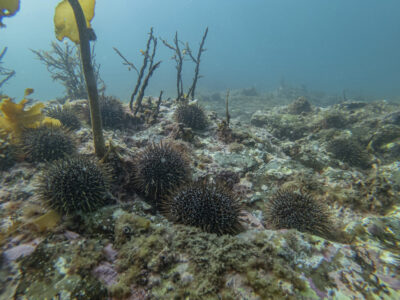
The Hauraki Gulf Forum welcomes today’s announcement of the Government’s long-awaited response to the Sea Change Tai Timu Tai Pari plan for the Hauraki Gulf.
“Proposed new marine protected areas and changes to bottom-impact fishing, if implemented, would represent the most positive change for the Gulf in a generation,” says Hauraki Gulf Forum co-chair Pippa Coom.
The Hauraki Gulf Forum notes that the Government has largely stuck with the 2016 consensus established in the Sea Change plan. However, iwi, hapū and community ambition has increased significantly in the five years since it was written.
“We call on the Government to ensure that the plan is inclusive,” says Coom.
“In many areas of the Hauraki Gulf there are new, bold plans for marine protection and restoration led by and in partnership with mana whenua.
“It is important that the Government’s Sea Change response creates a mechanism by which existing proposals can be upgraded, and new proposals considered.”
The Government’s response, if implemented, would raise the area of the Hauraki Gulf Marine Park that is fully protected to about five per cent from less than one per cent at present.
Another area where the Forum urges more ambition is fully protecting the seafloor of the Marine Park from destructive fishing methods. While the Government’s plan is to be commended for further restricting such activity, some areas will remain at risk, Coom says.
“The Forum’s position is clear: bottom-impact fishing methods like dredging and trawling should be removed from the entire Marine Park,” she says.
“A healthy seafloor underpins the whole ecosystem.”
The release of the Government’s response strategy to Sea Change comes after nearly a decade of work by so many to draft, agree, and move forward the marine spatial plan, says Coom.
“The Hauraki Gulf Forum pays tribute to all those, past and present who have helped bring us to this point today.”
Forest & Bird: A step towards restoring Hauraki Gulf
The Government needs to be more ambitious with its plans to restore the Hauraki Gulf back to the thriving ocean ecosystem it was only a few generations ago, says Forest & Bird CE Kevin Hague.
“The Minister of Oceans and Fisheries David Parker and the Minister of Conservation Ayesha Verrall deserve credit for getting us this far and there are good proposals here, but if we want to bring back healthy ecosystems and abundant marine life we need to go further,” says Hague.
“Around 20 per cent of the world’s seabird species have been recorded in the wider Gulf, and almost a third of Aotearoa New Zealand’s seabirds breed there. This is an incredibly important place.
“The severity of the degradation of the Gulf means we need to be ambitious and determined to restore its health. It’s within our reach to bring back the health of the Gulf, but this plan at it stands is unlikely to get us there.
“The big gaps in the Hauraki Gulf plan are around bottom trawling and dredging, run-off, and marine protected areas.
“Fishing methods that harm the seabed, like bottom trawling, must end entirely. Wherever they occur, they devastate the marine ecosystem.
“We have seen no provisions in the strategy for ending the polluting run-off from the Firth of Thames and from Auckland City. Every time it rains, sewage, heavy metals, sediment and mud flow into the Gulf, making it unswimmable for humans and harmful to wildlife.
“There needs to be many more protected areas in the Gulf. The 18 proposed reserves must be a starting point moving towards 30 per cent protection, not the end point in themselves.
“Ecosystem-based management needs to allow for the restoration of kelp and mangrove forests which are essential habitats for fish, birds and insects, as well as storing significant amounts of carbon.
“The regulatory framework needs to have a feedback loop of monitoring where it’s mandatory to increase protection if science says that the Gulf is not being restored.”
Forest & Bird urges the Government to increase its ambition by:
- Working with iwi/hapu to progressively increase protection from the proposed 18 per cent up to 30 per cent.
- Phasing out bottom trawling, Danish seining and scallop dredging from the Gulf
- Ensuring the Fisheries Plan for the Gulf protects food for wildlife as well as people
- Working with local and regional councils to clean up waterways that flow into the Gulf, and prevent new pollution and marine dumping
- Putting in place a robust feedback loop for the Fisheries Plan and the marine protected areas to increase protection if restoration of ecosystems isn’t on track.
The Government’s plan, released today includes:
- Creating 18 new marine protection areas and a framework to support the active restoration of some of the most biodiverse regions in the Gulf. The 18 new protected areas will increase marine protection in the Gulf almost threefold.
- Developing a Fisheries Plan with a range of changes to fishing practices and catch settings, including restricting trawl fishing to within carefully selected corridors.
- Carrying out better monitoring to improve our understanding of the marine environment and track progress over time.
- Developing an expanded programme of protected species management.
- Working together with mana whenua and local communities on local area coastal management.
- Promoting a prosperous, sustainable aquaculture industry.
What is the Hauraki Gulf Marine Park?
The Hauraki Gulf Marine Park New Zealand’s first marine park.
It’s a big park, stretching from Te Arai in the north to Waihi in the south.
At 1.2 million hectares, or 20 times the size of Lake Taupō, it includes the Waitematā Harbour, Gulf Islands, Firth of Thames and the east coast of the Coromandel Peninsula.
The Park was established by the Hauraki Gulf Marine Park Act in February 2000.
It is the seabird capital of the world, and a whale superhighway. But it is a shadow of its former self, as six State of the Gulf reports have shown.
What is the Hauraki Gulf Forum?
The Hauraki Gulf Forum is a statutory governance board established under the Marine Park Act to advocate for the Gulf.
The Forum has representation on behalf of the tangata whenua of the Hauraki Gulf and its islands, the Ministers of Conservation, Fisheries and Māori Development, and elected representatives from Auckland Council (including Aotea Great Barrier Island and Waiheke Island Local Boards), Waikato Regional Council, and the Waikato, Hauraki, Thames-Coromandel and Matamata-Piako District Councils.
The Forum is required to present triennial reports regarding the state of the environment of the Hauraki Gulf Marine Park.
More information on the Forum and the Marine Park is available here.








